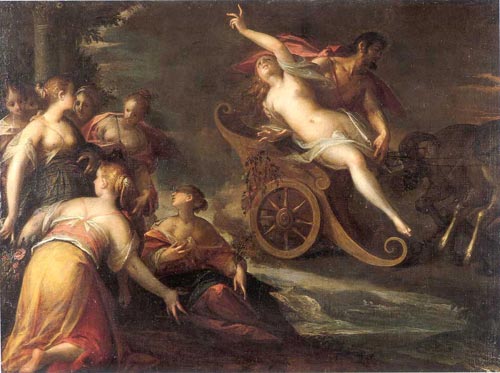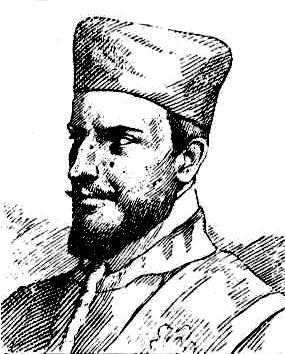|
Giulio Strozzi
Giulio Strozzi (1583 - 31 March 1652) was a Venetian poet and libretto writer. His libretti were put to music by composers like Claudio Monteverdi, Francesco Cavalli, Francesco Manelli, and Francesco Sacrati. He sometimes used the pseudonym Luigi Zorzisto. Biography Giulio Strozzi was a bastard, and later legitimized, son of Roberto Strozzi, from the Strozzi family. Born in Venice in 1583, he first studied there before going to the University of Pisa to study law. He lived and worked in Rome, Padua and Urbino before returning to Venice in the 1620s. He was the adoptive father of composer Barbara Strozzi (born in 1619 from Isabella Garzoni, a woman servant living in Strozzi's house, and possibly his illegitimate daughter). He remained there until his death on 31 March 1652. Work He wrote poetry and plays, but is best remembered as one of the first writers of libretti, the texts used for all kinds of musical plays but most specifically opera. His earliest known work was in 1609 ... [...More Info...] [...Related Items...] OR: [Wikipedia] [Google] [Baidu] |
Baroque
The Baroque (, ; ) is a style of architecture, music, dance, painting, sculpture, poetry, and other arts that flourished in Europe from the early 17th century until the 1750s. In the territories of the Spanish and Portuguese empires including the Iberian Peninsula it continued, together with new styles, until the first decade of the 19th century. It followed Renaissance art and Mannerism and preceded the Rococo (in the past often referred to as "late Baroque") and Neoclassical styles. It was encouraged by the Catholic Church as a means to counter the simplicity and austerity of Protestant architecture, art, and music, though Lutheran Baroque art developed in parts of Europe as well. The Baroque style used contrast, movement, exuberant detail, deep colour, grandeur, and surprise to achieve a sense of awe. The style began at the start of the 17th century in Rome, then spread rapidly to France, northern Italy, Spain, and Portugal, then to Austria, southern Germany, and Rus ... [...More Info...] [...Related Items...] OR: [Wikipedia] [Google] [Baidu] |
La Finta Pazza Licori
The Italian composer Claudio Monteverdi (1567–1643), in addition to a large output of church music and madrigals, wrote prolifically for the stage. His theatrical works were written between 1604 and 1643 and included operas, of which three—''L'Orfeo'' (1607), ''Il ritorno d'Ulisse in patria'' (1640) and ''L'incoronazione di Poppea'' (1643)—have survived with their music and librettos intact. In the case of the other seven operas, the music has disappeared almost entirely, although some of the librettos exist. The loss of these works, written during a critical period of early opera history, has been much regretted by commentators and musicologists. Opera, as a musical and theatrical genre, began to emerge during the early part of Monteverdi's career, initially as a form of courtly entertainment. With other composers, he played a leading part in its development into the main form of public musical theatre. His first opera, ''L'Orfeo'', written in 1607 for the Mantuan court, ... [...More Info...] [...Related Items...] OR: [Wikipedia] [Google] [Baidu] |
Cosimo II De' Medici, Grand Duke Of Tuscany
Cosimo II de' Medici (12 May 1590 – 28 February 1621) was Grand Duke of Tuscany from 1609 until his death. He was the elder son of Ferdinando I de' Medici, Grand Duke of Tuscany, and Christina of Lorraine. For the majority of his twelve-year reign, he delegated the administration of Tuscany to his ministers. He is best remembered as the patron of Galileo Galilei, his childhood tutor. Biography Cosimo's father Ferdinando I took care to provide him with a modern education. Indeed, Galileo Galilei was Cosimo's tutor between 1605 and 1608. Ferdinando arranged for him to marry Archduchess Maria Maddalena of Austria, daughter of Archduke Charles II, in 1608. Their marriage was celebrated with an elaborate display on the Arno, which included a performance of the ''Argonautica'', in which Jason sailed around an artificial island and presented Maria Maddalena with six red apples, alluding to the Medici family symbolic balls, or palle. Cosimo and Maria Maddalena had eight childr ... [...More Info...] [...Related Items...] OR: [Wikipedia] [Google] [Baidu] |
La Finta Savia
''La finta savia'' is a 1643 drama by Giulio Strozzi written for the Teatro Santi Giovanni e Paolo with music by Filiberto Laurenzi. It is a sequel to Strozzi's '' La finta pazza'' (1641) whi was set to music by Francesco Sacrati. The music was mainly by Laurenzi but was supplemented in act 1 with scenes 3 to 5, 10 and 12 by Tarquinio Merula, in scene 6 mainly by Arcangelo Crivelli except for a canzonetta by Laurenzi. In act 1, scenes 2 and 3 were by Crivelli and in act 3 scenes 1 and 7 to 9 by Benedetto Ferrari. by John Whenham, '' The New Grove Dictionary of Opera'' R ...
|
Proserpina Rapita
Proserpina ( , ) or Proserpine ( ) is an ancient Roman goddess whose iconography, functions and myths are virtually identical to those of Greek Persephone. Proserpina replaced or was combined with the ancient Roman fertility goddess Libera, whose principal cult was housed in the Aventine temple of the grain-goddess Ceres, along with the wine god Liber. Each of these three deities occupied their own ''cella'' at the temple. Their cults were served or supervised by a male public priesthood. Ceres was by far the senior of the three, one of the dii consentes, Rome's approximate equivalent to the Greek Twelve Olympians. She was identified with Greek Demeter and Liber was identified with Bacchus and Dionysus. Libera is sometimes described as a female version of Liber Pater, concerned with female fertility. Otherwise she is given no clear identity or mythology by Roman sources, and no Greek equivalent. Nothing is known of her native iconography: her name translates as a feminine form ... [...More Info...] [...Related Items...] OR: [Wikipedia] [Google] [Baidu] |
Giovanni Rovetta
Giovanni Rovetta (c. 1595/97–1668) was an Italian Baroque composer and ''maestro di capella'' of the Capella Marciana at St Mark's Basilica, Venice between Monteverdi and Cavalli. He may have been a choirboy at St. Mark's, where his father played: the earliest document is of his admission in December 1614 as a permanent member of the ''capella'' and he remained at S. Marco for the rest of his career. He was a chorister, instrumentalist, bass, and vice-director under Monteverdi, and finally served as Monteverdi's successor from 1664 until his death. He was also the director of the Ospedale dei Derelitti (Ospedaletto) between 1635 and 1647. His students included his nephew Giovanni Battista Volpe (known as ''Rovettino'') and the Venetian composer Giovanni Legrenzi. His compositions include several volumes of madrigals and a great deal of sacred music, especially masses, psalms, and motet In Western classical music, a motet is mainly a vocal musical composition, of highly di ... [...More Info...] [...Related Items...] OR: [Wikipedia] [Google] [Baidu] |
Gelosia Placata , from opera "Ottone in villa" by Antonio Vivaldi
{{disambiguation ...
Gelosia may refer to: * Gelosia (1915 film), directed by Augusto Genina * Jealousy (1942 film), directed by Ferdinando Maria Poggioli *Jealousy (1953 Italian film), directed by Pietro Germi *Gelosia multiplication, or Lattice multiplication *Gelosia (Aria) Gelosia may refer to: * Gelosia (1915 film), directed by Augusto Genina * Jealousy (1942 film), directed by Ferdinando Maria Poggioli *Jealousy (1953 Italian film), directed by Pietro Germi *Gelosia multiplication, or Lattice multiplication Latt ... [...More Info...] [...Related Items...] OR: [Wikipedia] [Google] [Baidu] |
Accademia Degli Incogniti
The Accademia degli Incogniti (Academy of the Unknowns), also called the Loredanian Academy, was a learned society of freethinking intellectuals, mainly noblemen, that significantly influenced the cultural and political life of mid-17th century Venice. The society was founded in 1630 by Giovanni Francesco Loredan and Guido Casoni, and derived its basic Aristotelian philosophy from Cesare Cremonini, a Peripatetic who was professor of philosophy at the University of Padua.Rosand, pp. 37–40 The society included historians, poets, and librettists. According to historian Ellen Rosand, the academy, in keeping with its name, usually operated behind the scenes. Members often wrote in a secret language and frequently published their works anonymously. The Accademia degli Incogniti was particularly active in the promotion of musical theater in Venice from the 1630s onward, founding its own theater, the Teatro Novissimo, which flourished briefly between 1641 and 1645. In their libr ... [...More Info...] [...Related Items...] OR: [Wikipedia] [Google] [Baidu] |
Veremonda
''Veremonda, l'amazzone di Aragona'' (''Veremonda, the Amazon of Aragon''; also known as ''Il Delio'') is an opera in three acts and a prologue by the Italian composer Francesco Cavalli. The libretto is by Giulio Cicognini with revisions by Giulio Strozzi. The date of the Venetian performance is uncertain. Performance history The Venetian libretto indicates 28 January 1652 but this could refer also to 1653 if the Venetian calendar applied (where the new year began on March 1). The opera was also performed at the Nuovo Teatro del Palazzo Reale in Naples on 21 December 1652, to celebrate the Spanish capture of Barcelona, which put an end to the revolt of Catalonia Catalonia (; ca, Catalunya ; Aranese Occitan: ''Catalonha'' ; es, Cataluña ) is an autonomous community of Spain, designated as a '' nationality'' by its Statute of Autonomy. Most of the territory (except the Val d'Aran) lies on the no ... (Naples was also a Spanish possession). Roles in the Venetian libre ... [...More Info...] [...Related Items...] OR: [Wikipedia] [Google] [Baidu] |
Proserpina Rapita
Proserpina ( , ) or Proserpine ( ) is an ancient Roman goddess whose iconography, functions and myths are virtually identical to those of Greek Persephone. Proserpina replaced or was combined with the ancient Roman fertility goddess Libera, whose principal cult was housed in the Aventine temple of the grain-goddess Ceres, along with the wine god Liber. Each of these three deities occupied their own ''cella'' at the temple. Their cults were served or supervised by a male public priesthood. Ceres was by far the senior of the three, one of the dii consentes, Rome's approximate equivalent to the Greek Twelve Olympians. She was identified with Greek Demeter and Liber was identified with Bacchus and Dionysus. Libera is sometimes described as a female version of Liber Pater, concerned with female fertility. Otherwise she is given no clear identity or mythology by Roman sources, and no Greek equivalent. Nothing is known of her native iconography: her name translates as a feminine form ... [...More Info...] [...Related Items...] OR: [Wikipedia] [Google] [Baidu] |
La Finta Pazza
''La finta pazza'' (''The feigned madwoman'') is an opera composed by Francesco Sacrati to a libretto by Giulio Strozzi. Its premiere in Venice during the Carnival season of 1641 inaugurated the Teatro Novissimo. It became one of the most popular operas of the seventeenth century. History Venice, 1641 On 30 May 1640, the decision was made to create a new opera house in Venice, to compete with the existing three opera houses, the Teatro San Cassiano, the Teatro Santi Giovanni e Paolo, and the Teatro San Moisè. The Teatro Novissimo marked the first time that a building was created specifically for opera. Early in 1641, before the opera had been performed for the first time, the libretto was already printed. This was highly unusual and a first for Venice, but would become standard practice at the Teatro Novissimo. Giulio Strozzi was already a well-established libretto writer at the time, and had in 1627 collaborated with Claudio Monteverdi on '' La finta pazzi Licori'', an aborte ... [...More Info...] [...Related Items...] OR: [Wikipedia] [Google] [Baidu] |


.jpg)

.jpg)

